5 Brilliant Ways to Use #Hashtags in Social Media Marketing
Posted on: Sunday, February 23rd, 2014
On July 2, 2009, Twitter officially embraced hashtags and hyperlinked them to search results. Tumblr was one of the early adopters of hashtags when it launched hashtags on August 18, 2009. A few months later, on March 30, 2010, in another homepage redesign, Twitter moved Trending Topics to its homepage, formalizing hashtags as a conversation driver on Twitter.
As Twitter users adopted hashtags as a normal part of the Twitter conversation, in a typical fashion to Twitter, hashtags stared in popular culture like TV shows, celebrities’ promotions and mainstream media.
[youtube https://www.youtube.com/watch?v=57dzaMaouXA]
The pop-culture adoption of hashtags helped push hashtags into other social networks. Instagram adopted hashtags on January 27, 2011, Flickr added hashtags on March 17, 2013 and Facebook finally broke and adopted hashtags on June 12, 2013.
Hashtags Adopted as a Marketing Tactic
An analysis of the Interbrand 100 list (the world’s top 100 brands) and their activity on Twitter, reveals that the world’s top brands have adopted the use of hashtags almost completely. In Q4 of last year, 97 percent of the brands posted at least one tweet that included a hashtag. Out of the 34,707 regular tweets (tweets that don’t include an @ reply or a retweet) that the Interbrand 100 companies posted, 45 percent included at least one hashtag and more than 67 percent included one or more hashtags.
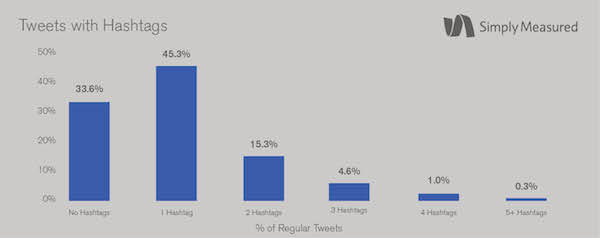
1. Drive Engagement: # + Link = More Engagement
These companies have realized that hashtags help drive engagement. When compared to Tweets without a hashtag, tweets with hashtags showed 12 percent more engagement (RT, favorite or @ reply). Tweets that included a link anda hashtag, showed the highest engagement rate of any other type of tweet.
2. Test Your Messaging: #SOTU
During the last State of the Union address (#SOTU), the White House media team prepared content and tested 26 different hashtags.
- #SOTU
- #StateOfTheUnion
- #OutOfManyWeAreOne
- #OpportunityForAll
- #CollegeOpportunity
- #MadeInAmerica
- #ActOnClimate
- #ActForOurVets
- #RebuildAmerica
- #ActOnJobs
- #InvestInSTEM
- #ActOnCIR
- #ActOnUI
- #ActOnPreK
- #ConnectED
- #EqualPay
- #RaiseTheWage
- #ActOnTenTen
- #GetCovered
- #ACA
- #PeopleOverPolitics
- #RightToVote
- #ActForOurKids
- #SaluteOurTroops
- #Iran
- #TeamUSA
- #ActForOurTroops
- #SOTUChat
The next day (January 29) the White House focused on only seven of these hashtags and the vast majority of its tweets promoted the top three hashtags:
- #OpportunityForAll
- #RaiseTheWage
- #EqualPay
- #ActOnJobs
- #ActOnTenTen
- #CollegeOpportunity
- #MadeInAmerica
They did so because those hashtags resonated the best with audience on Twitter.
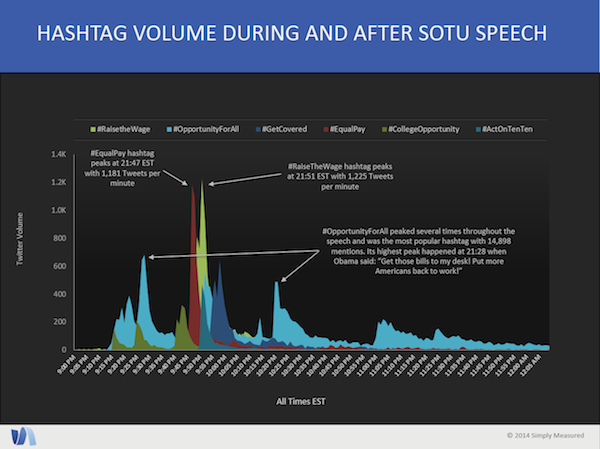
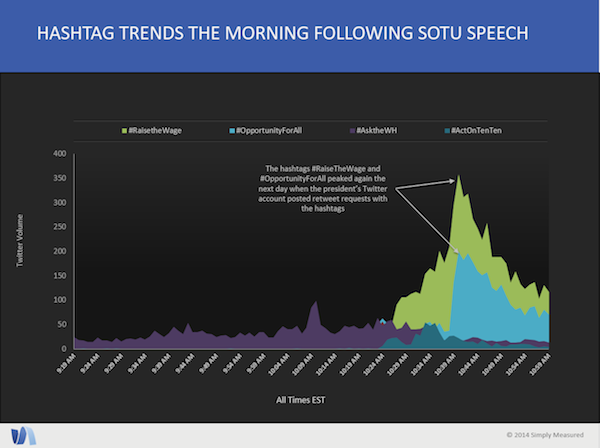
As evident by these charts, the White House team used Twitter to test the messages in the president’s speech and the following day applied their lessons to emphasize and reinforce the ones that stuck.
The #SOTU campaign is a master class in digital media campaign management, and this was one of the best lessons from it.
3. Tie Activity Across Multiple Channels: #SB48
During #SB48, ads included more hashtags than any other social signal including Twitter handles and Facebook account names. Brands used hashtags because of their cross-channel nature.
Since most social media channels adopted hashtags as an identifier, brands can now run cross-channel campaigns with one common identifier, virtually making hashtags the global connector of the social web.

4. Create a Story: #esurancesave30
Following the Super Bowl, Esurance ran an ad promoting the hashtag #esurancesave30. Within minutes, the hashtag got tens of thousands of mentions and within an hour it racked over 1.4 million mentions. With a simple, albeit expensive, campaign, Esurance created a story that was featured the next day on media outlets, blogs, and last Wednesday on TV.
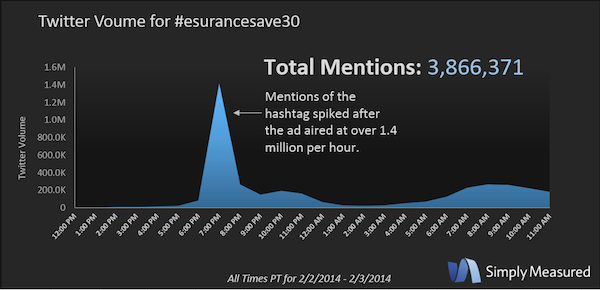
The hashtag brought to Esurance more than just attention, it gave them a list of people who actually engaged with their story and brand.
In the minutes following the ad, the Esurance Twitter account added more than 40,000 followers, more than doubling its followers in a matter of minutes. And in the days following the ad, the account added more than 250,000 followers, almost 10 times it’s audience size prior to the ad airing.
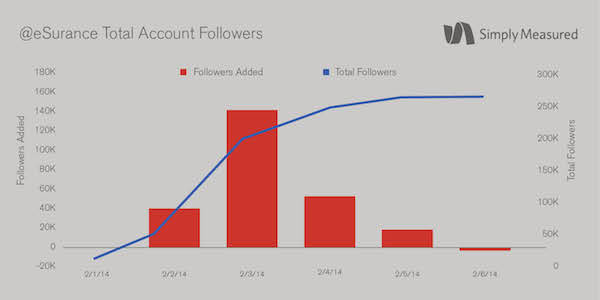
5. Track Results: #Whosgonnawin
Leading to the Super Bowl, the NFL and Verizon created a campaign to allow fans to vote on who they think is going to win the Super Bowl. By tweeting the team’s name with the hashtag #WhosGonnaWin fans voted for their favorite team.
Verizon and the NFL created a special website to track the results in real timehttp://www.whosgonnawin.com/ every day a new question was posted and fans voted using Twitter. By the end of the day, the team with the most mentions got to light up the Empire State Building.
[youtube https://www.youtube.com/watch?v=i9iOkUTlnq0]
Summary
Hashtags have become more than just a way to categorize posts or add a narrative to your updates. Marketers have found new, innovative ways to use hashtags as a mean to drive conversation, harness the public support, and garner attention to their brands.
Are you using hashtags? Who else have you seen using hashtags smartly?
![]() Early Bird Rates Expire Soon!
Early Bird Rates Expire Soon!
ClickZ Live (Mar 31-Apr 3) is a brand new global conference series kicking off in New York City. Over 3 days of sessions, keynotes, training workshops and networking you’ll gain invaluable digital marketing and advertising take-aways.
Register now and save up to $400 ››
*Early Bird Rates expire Feb 21.
No comments yet.
The comments are closed.

